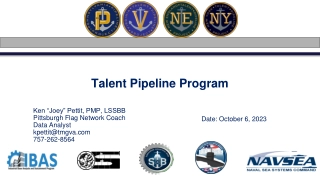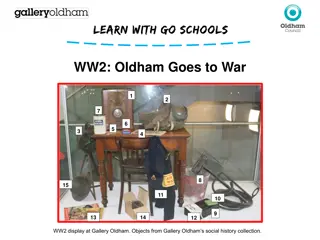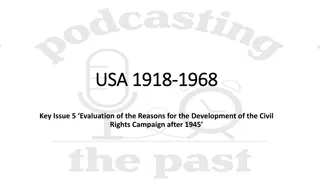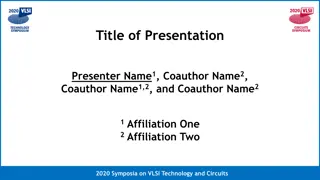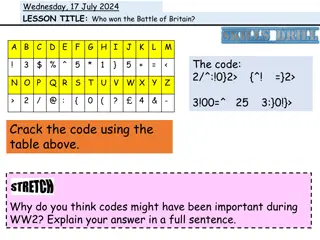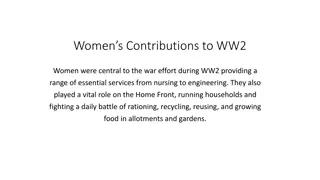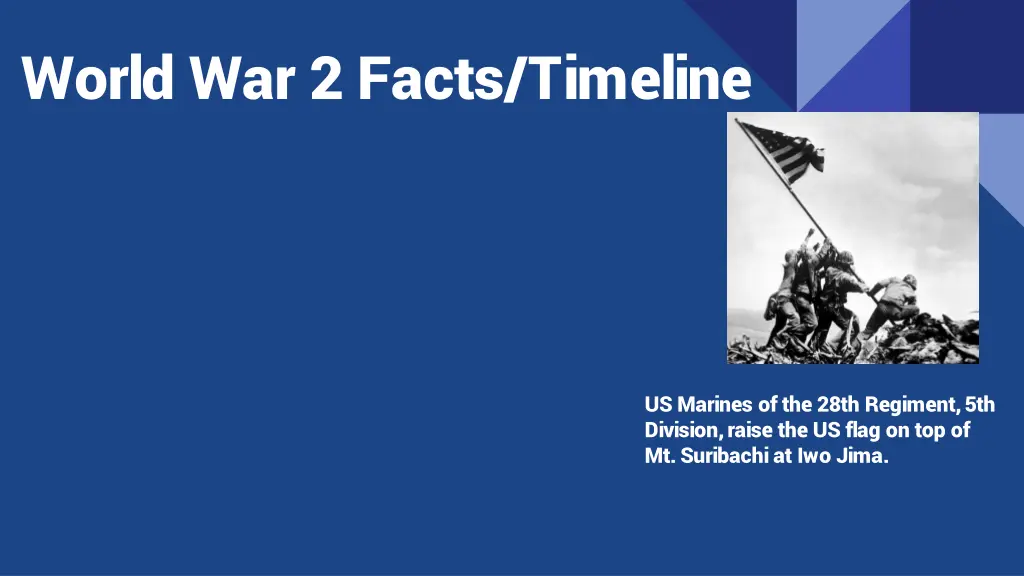
World War 2 Facts and Timeline: Battle of Iwo Jima, Hitler, Enola Gay, and More
Explore fascinating facts and timelines from World War 2, including the bloodiest Battle of Iwo Jima, Hitler, Operation Barbarossa, Enola Gay, and more. Witness key events unfold in the European/African Theater from 1939 to 1941. Discover unique stories of bravery and strategic maneuvers during one of the most significant conflicts in history.
Download Presentation

Please find below an Image/Link to download the presentation.
The content on the website is provided AS IS for your information and personal use only. It may not be sold, licensed, or shared on other websites without obtaining consent from the author. If you encounter any issues during the download, it is possible that the publisher has removed the file from their server.
You are allowed to download the files provided on this website for personal or commercial use, subject to the condition that they are used lawfully. All files are the property of their respective owners.
The content on the website is provided AS IS for your information and personal use only. It may not be sold, licensed, or shared on other websites without obtaining consent from the author.
E N D
Presentation Transcript
World War 2 Facts/Timeline US Marines of the 28th Regiment, 5th Division, raise the US flag on top of Mt. Suribachi at Iwo Jima.
Fast Facts -The bloodiest battle in this history of the Marine Corps was the Battle of Iwo Jima. Over 27,000 Marine casualties were reported on the 9.162 mi island. Of the 18,000 Japanese soldiers defending the island, 216 survived. -There has been only one recording of Hitler speaking normally in a conversation. -When Germany invaded the USSR during Operation Barbarossa, they invaded across a front which spanned 1,500 miles. That s longer than the Eastern US Seaboard! -The plane which dropped Little Boy on Hiroshima was named Enola Gay .
Fast Facts (Part 2) -Owen J Baggott is famous for shooting down a Japanese plane with an M1911 pistol while parachuting. -The youngest WWII Fighter was 12. His name was Calvin Graham, and he was given a dishonorable discharge. Prior to the discharge, he saw fighting in the Battle of Santa Cruz and he was awarded the Bronze Star Medal and a Purple Heart. -Canada produced more trucks than the Axis powers combined.
Timeline: European/African Theater-1939 1939: March 15: Nazis invade Czechoslovakia; March 28: Spanish Civil War Ends; September 1: Germany invades Poland; September 3: Britain, France, Australia, and New Zealand declare war on Germany; September 4: The Royal Air Force attacks the German navy; September 17: Soviets invade Poland; September 27: Poland surrenders;
Timeline: European/African Theater-1940 January 8: Rationing begins in Britain; March 16: Germans bomb Scapa Flow naval base near Scotland; April 9: Nazis invade Denmark and Norway; May 10: Nazis invade France, Belgium, Luxembourg, and Netherlands; June 22: By now, Germany has defeated France, Belgium, Luxembourg, and Netherlands; July 10: Battle of Britain begins; September 13: Italians invade Egypt; December 9: Britain begins offensive on Italians in North Africa; beginning of North African theater;
Timeline: European/African Theater-1941 January 22: Tobruk in North Africa falls to Britain and Australia; February 11-14: British army advances into Italian-controlled territory in East Africa; Erwin Rommel arrives in North Africa; First Afrika Korps units arrive at North Africa; May 24-27: Sinking of the Hood by the Bismarck; Bismarck is sank by the British Navy; June 22: Operation Barbarossa begins; July 3: Stalin calls for a scorched Earth policy October 2: Operation Typhoon begins; October 16-December 7: Germans take Odessa, Kharkov, Sevastopol, and Rostov; Soviets retake Rostov and Russian winter causes the attack on Moscow to be abandoned. Soviets begin counteroffensive and the Japanese bomb Pearl Harbor.
Timeline: European/African Theater-1942 January 26: American forces land in Britain; April: Japanese Americans sent to relocation camps; May 30: Britain launches its first 1,000 bomber air raid (against Cologne); June: Mass murder of Jews begins at Auschwitz; June 25: Eisenhower gets to London; August 17: First All-American air attack in Europe; September 13: Battle of Stalingrad begins; October 18-November 19: Hitler orders executions of all British POWs; Operation Torch begins (US invasion of North Africa); Soviets begin counter-offensive of Stalingrad;
Timeline: European/African Theater-1943 January 10: Soviets begin an offensive against the Germans at Stalingrad; January 23-27: General Montgomery s eighth army takes Tripoli in Libya; First US bombing raid on Germany at Wilhelmshaven; February 2: Germans surrender at Stalingrad in Hitler s first major defeat; February 18: Nazis arrest White Rose leaders near Munich; March 2: Germans withdraw from Tunisia; May 7: Allies take Tunisia; May 13: German and Italian troops surrender in North Africa; June 11: Heinrich Himmler orders the destruction of all jewish ghettos in Poland.
Timeline: European/African Theater-1943(Part 2) July 9: Allies land in Sicily; July 19: Allies bomb Rome; July 22: Allies capture Palermo, a city in Sicily; July 25/26: Mussolini is arrested and Italy s fascist government collapses. Marshall Badoglio takes the lead of the country and negotiates with the Allies; September 8: Italy s surrender to the Allies is announced; September 11: Germans occupy Rome; September 12: Mussolini is rescued in the Gran Sasso Raid. September 23: Mussolini re-establishes a fascist government in Italy.
Timeline: European/African Theater-1943(Part 3) October 1: Allies enter Naples; October 13: Italy declares war on Germany; November 6: Soviets recapture Kiev in Ukraine; November 18: British launch large air raid on Berlin; December 24-26: Soviets launch offensives on the Ukrainian front;
Timeline: European/African Theater-1944 January 6: Soviet troops enter Poland; January 27:Leningrad is freed after a 900-day siege; February 15-18: Allies bomb the Monte Cassino monastery; April 8: Soviet troops began an offensive to capture Crimea; May 12: Germans surrender at Crimea; June 5: Allies enter Rome; June 6: D-Day invasion begins at Normandy; June 13: First German V-1 rocket hits Britain;
Timeline: European/African Theater-1944(Part 2) June 22: Operation Bagration begins; June 27: US troops liberate Cherbourg, a town in France; July 20: Assassination attempt on Hitler by his Army officers fails; July 24: Soviets liberate first concentration camp at Majdanek; August 4: Anne Frank and her family is arrested by Gestapo; August 19: Resistance uprising in Paris; August 25: Liberation of Paris; September 4: Soviets and Finland agree to ceasefire; October 2: Warsaw uprising ends when Polish Home Army surrenders to the Germans;
Timeline: European/African Theater-1944(Part 3) October 14: Allies liberate Athens, which causes Rommel to commit suicide; October 21: Massive surrender by the Germans at Aachen, Germany; October 30: Last use of gas chambers at Auschwitz; December 4: Greece falls into civil war, Athens is put under martial law; December 16-27: Battle of the Bulge occurs in the Ardennes;
Timeline: European/African Theater-1945 January 1-17: Germans leave the Ardennes; January 26: Soviets liberate Auschwitz concentration camp; March 6: Last German offensive, begins to defend oil fields in Hungary; March 7: Allies take Cologne and use a bridge to cross the Rhine at Remagen; March 30: Soviets capture Danzig; April: Allies discover stolen art and treasure in Nazi salt mines; April 1: Allies circle the Germans in the Ruhr; April 12: Allies liberate Buchenwald and Belsen camps, Roosevelt dies and Truman becomes president; April 16-18: Soviets begin final offensive on Berlin; Germans in the Ruhr surrender;
Timeline: European/African Theater-1945(Part 2) April 21: Soviets reach Berlin; April 28: Mussolini is captured and hanged by Italian rebels; April 29: U.S. troops liberate Dachau; April 30: Adolf Hitler commits suicide; May 2-7: German troops surrender in Italy on the 2nd, while on the 7th the Germans surrender. The war in the European/African theater is now over. July 16: First nuclear bomb test is conducted; August 6: First atomic bomb (Nicknamed Little Boy) is dropped on Hiroshima; August 8-9: Soviets declare war on Japan on the 8th and invade Manchuria, and on the 9th the US drops a second atom bomb (Nicknamed Fat Man) on Nagasaki, which causes Japan to surrender. This is the end of the war.
Why I chose to do this I chose to do this because we need to remember the people who fought and lost their lives because of WWll. I also chose to do this because my grandfather fought in this war and I wanted to learn more about what he did.
Thank you for watching! Credit: Link 1 Link 2

